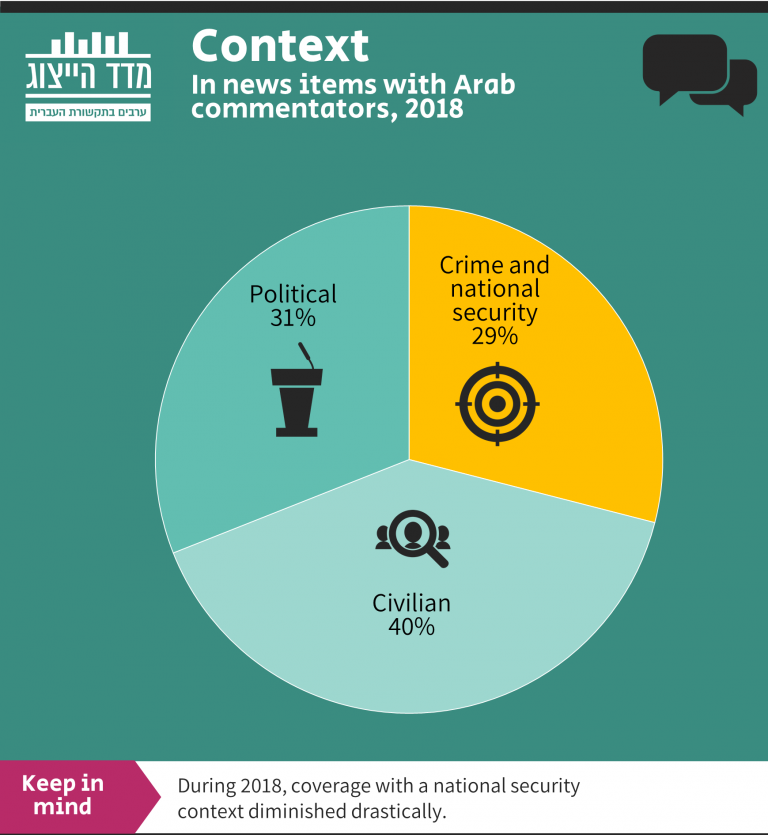 The Media Representation Index (English summary) quantifies the appearance of Arab commentators and experts in Hebrew broadcast news coverage. In 2018, the third annual index showed an increase in the number of Arab women interviewees and peak rates for Arab representation in the second half of the year, while overall representation for the year remained the same as 2017.
The Media Representation Index (English summary) quantifies the appearance of Arab commentators and experts in Hebrew broadcast news coverage. In 2018, the third annual index showed an increase in the number of Arab women interviewees and peak rates for Arab representation in the second half of the year, while overall representation for the year remained the same as 2017.
The Index also notes substantial coverage in 2018 of topics such as violence against women as well as violence and crime in Arab society, “in contrast to the general disregard and exclusion normally characterizing past media interest on such matters.”
Full Study in Hebrew
The Index is a project of the Sikkuy Association for the Advancement of Civic Equality to promote greater frequency and diversity of Arab representation in Israel’s Hebrew broadcast news, conducted in cooperation with the Seventh Eye Magazine and Ifat Media Research.
Periodically throughout the year, the Seventh Eye draws attention to this issue by highlighting how often specific media outlets include Arab commentators, how different programs compare, and noting the degree to which news coverage of certain topics includes or does not include Arab speakers. Data on the scope and nature of representation is collected throughout the year and presented at year-end.
2018 Results
The overall average of representation in 2018 remained identical to 2017 at 2.9% (4,120 Arab commentators out of roughly 140,000 in Israeli media programs), though both years saw higher rates than 2016, the first year of the project’s launch, which stood at 2.5%.
Two events that significantly influenced Arabs’ representation rates in 2018 were the Nation-State Law and its aftermath and the campaign against femicide and violence towards women in Arab society and beyond.
- Nation-State Law: In the second half of 2018, coverage of the Nation-State Law, the most discussed topic of the year vis-à-vis Arab society, brought Arab representation as part of news coverage to a peak of 3.5%, the highest since the inception of the Index. However, this representation centered primarily on the Druze population with most Arab commentators on the subject coming from the Druze community.
- Violence Against Women: Coverage of the campaign against violence towards women brought the rate of Arab women commentators in Hebrew broadcast media to roughly 20% of Arab commentators, the highest rate since the project’s launch and an improvement from 18% in 2017 and 16% in 2016.
The average proportion of Arab commentators in the 21 leading current affairs programs on television and radio increased slightly as well, from 4.6% in 2017 to 4.7%, compared to 4.3% in 2016.
The Index also examines the contexts in which Arab speakers are most frequently featured, including security and crime, politics, and civic issues (culture, welfare, health, foreign affairs, and more), with the goal of helping to promote the appearance of Arab speakers on topics beyond regional conflict or violent escalations. Only 29% of Arab speakers were featured in the context of security and criminal issues compared to 51% in 2017, while 31% were featured in a political context, a major jump from 7% in 2017 largely due to the Nation-State Law and related events. With other issues taking center stage, only 5% of Arab speakers were featured in a security context, which was the most prominent interest area in 2017. The proportion of Arab speakers on civic issues remained similar at 40% compared to 42% in 2017.
Overall, despite some improvement, representation of Arabs in mainstream Israeli media remains far from proportional to the size of Arab society, which comprises approximately 20 percent of the Israeli population.
Sikkuy partnered with ANU, an organization that promotes shared society, to create the A-List database of Arab experts to make specialized and diverse Arab speakers accessible to media.
 The Media Representation Index (
The Media Representation Index (